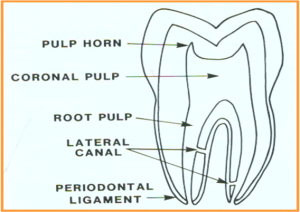The pulp has been described both as a highly resistant organ and as an organ with little resistance or recuperating ability.
Its resistance depends on cellular activity, nutritional supply, age, and other metabolic and physiologic parameters.
CAUSES OF PULP DISEASE
The cause of pulp disease are
Physical – Mechanical, Thermal, Electrical
Chemical
Bacterial
Physical
A. Mechanical
1. Trauma
a. Accidental (contact sports)
b. Iatrogenic dental procedures (wedging of teeth, cavity or crown preparation.
2. Pathologic Wear (Attrition, abrasion etc)
3. Crack through body tooth (cracked tooth syndrome)
4. Barometric changes (barodontalgia)
Traumatic injury may or may not be accompanied by fracture of the crown or root.
More in children than in adults.
May be due to a violent blow to the tooth during a fight, sports, automobile accident.
Habits such as opening bobby pins with the teeth, compulsive bruxism, nail biting, and thread biting by seamstresses may also cause pulpal injury.
In addition certain dental procedures occasionally injure the pulp.
Accidental exposure of the pulp during excavation of carious tooth structure.
Too-rapid movement of the teeth during orthodontic treatment
Use of Mechanical separator
Use of Pins for Mechanical retention of amalgam
Pathologic Wear:
The pulp may also become exposed or nearly exposed by pathologic wear of the teeth from either abrasion or attrition if secondary dentin is not deposited rapidly enough.
Cracked tooth syndrome:
Incomplete fractures through the body of the tooth may cause pain of apparently idiopathic origin. This is referred to as the “cracked tooth syndromeâ€. The patient usually complains of pain, ranging from mild to excruciating, at the initiation or the release of the biting pressure.
Barodontalgia:
Barodontalgia, also known as aerodontalgia denotes toothache occurring at low atmospheric pressure experienced either during flight or during a test run in a decompression chamber.
B. Thermal
1. Heat from cavity preparation, at either low or high speed
2. Exothermic heat from the setting of cement
3. Conduction of heat and cold through deep fillings without a protective base
4. Frictional heat caused by polishing a restoration
C. Electrical (galvanic current from dissimilar metallic fillings)
D. Radiation –
Laser radiation sufficient to cause cavitation in teeth also causes severe degenerative changes in the pulp.
II Chemical
Phosphoric acid, acrylic monomers, from restorative materials like composite
Erosion (Acids)
III Bacterial
Toxins associated with caries
Direct invasion of pulp from caries or trauma
Microbial colonization in the pulp by blood borne microorganisms (anachoresis)
BACTERIA
In 1894, W.D. Miller suggested that bacteria were a possible cause of inflammation in the pulp.
The most common cause of pulp injury is bacterial.
Bacteria or their products may enter the pulp through a break in the dentin, either from caries or accidental exposure,
From percolation around a restoration from extension of infection from the gingiva, or by way of the blood.
The presence or absence of bacterial irritation is the determining factor in pulp survival once the pulp has been mechanically exposed.
Once the bacteria have invaded the pulp the damage is almost always irreparable
The bacteria most often recovered from infected vital pulps are streptococci and staphylococci, but many other micro-organisms, from diphtheroids to anaerobes, have also been isolated.
Disease of The Pulp
Inflammation of the pulp:
Pulpitis or inflammation of the pulp may be acute or chronic, partial or total, and the pulp may be infected or sterile.
The diseases of dental pulp may be clinically classified as
I. PULPITIS (INFLAMMATION)
A. Reversible
1. Symptomatic (acute)
2. Asymptomatic (chronic)
B. Irreversible pulpitis
1. Acute
a. abnormally responsive to cold
b. abnormally responsive to heat
2. Chronic
a. asymptomatic with pulp exposure
b. hyperplastic pulpitis
c. Internal resorption
II. Pulp degeneration
Calcific (radiographic diagnosis)
Others (histopathologic diagnosis)
III Necrosis
Reversible Pulpitis:
Definition:
Reversible pulpitis is a mild to moderate inflammatory condition of the pulp caused by noxious stimuli in which the pulp is capable of returning to the uninflamed state following removal of the stimuli.
Pain of brief duration may be produced by thermal stimuli in the reversible inflamed pulp, but the pain subsides as soon as the stimulus is removed.
Cause:
Reversible pulpitis may be caused by any agent that is capable of injuring the pulp.
Specifically, the cause may be any of the following:
trauma, as from a blow or from a disturbed occlusal relationship.
Following insertion of a restoration, patients often complain of mild sensitivity to temperature changes, especially cold, Such sensitivity may last 2 to 3 days or a week, or even longer, but it gradually subsides. This sensitivity is symptomatic of reversible pulpitis.
Symptoms:
Symptomatic reversible pulpitis is characterized by sharp pain lasting but a moment.
It is more often brought on by cold than hot food or beverages and by cold air.
It does not occur spontaneously and does not continue when the cause has been removed.
The clinical differences between reversible and irreversible pulpitis is quantitative.
The pain of irreversible pulpitis the pain may come without any apparent stimulus
Asymptomatic reversible pulpitis may result from incipient caries and is resolved on removal of the caries and proper restoration of the tooth.
Treatment:
“PREVENTION IS BETTER THAN CUREâ€
Periodic care to prevent the development of caries.
Early insertion of a filling if a cavity has developed.
Desensitization of the necks of teeth where gingival recession is marked.
Use of a cavity varnish or cement base before insertion of a filling,
Care in cavity preparation and polishing are recommended, to prevent pulpitis.
